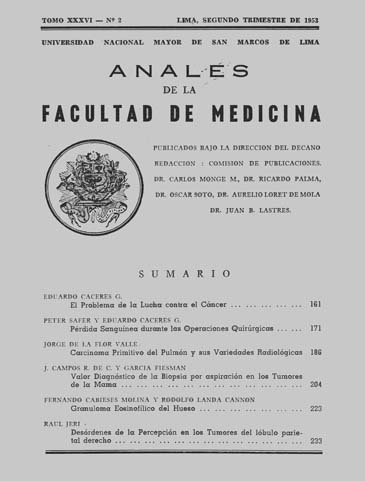Blood loss during surgery
DOI:
https://doi.org/10.15381/anales.v36i2.9183Abstract
Accurate knowledge of the total blood loss during surgery, helps to get maximum benefit from transfusions. Blood should be given to the volume and rate of loss. The maintenance of circulating volume of red blood cells in the normal range, should consider it as an elementary fact in surgery patients with poor surgical risk, particularly in heart, arteriosclerotic and those elderly who can not tolerate either an overload or a decrease in circulating volume. The methods used to measure blood loss during surgery are discussed. The authors apply the gravimetric method and recommend it as a routine procedure during surgery. A personal estimates of total blood lost during surgery is worthless. When it comes to control massive bleeding from several liters, the error can be so large that a lack of action may endanger the patient's life. The total blood loss during the operation obtained by the method recommended by the authors, is the minimum that should be replaced. Additional Sources of blood loss can not be determined by the gravimetric method are discussed. Numbers of blood loss in surgical operations obtained by Bonica and Lyter (561 cases), other (reported by Bonica and Lyter), and authors (109 cases) are presented. It is noted that blood loss during surgery is usually greater than the surgeon suspects. Blood loss of various operations is discussed and even large individual variation in the operations of the same type is annotated.Downloads
Published
1953-06-15
Issue
Section
Trabajos originales
License
Copyright (c) 1953 Peter Safer, Eduardo Cáceres G.

This work is licensed under a Creative Commons Attribution-NonCommercial-ShareAlike 4.0 International License.
Those authors who have publications with this magazine accept the following terms:
- Authors will retain their copyrights and guarantee the journal the right of first publication of their work, which will be simultaneously subject to Creative Commons Attribution License that allows third parties to share the work as long as its author and its first publication this magazine are indicated.
- Authors may adopt other non-exclusive licensing agreements for the distribution of the version of the published work (eg, deposit it in an institutional electronic file or publish it in a monographic volume) provided that the initial publication in this magazine is indicated.
- Authors are allowed and recommended to disseminate their work over the Internet (eg: in institutional telematic archives or on their website) before and during the submission process, which It can produce interesting exchanges and increase quotes from the published work. (See El efecto del acceso abierto ).
How to Cite
1.
Safer P, Cáceres G. E. Blood loss during surgery. An Fac med [Internet]. 1953 Jun. 15 [cited 2024 Aug. 16];36(2):171-85. Available from: https://revistasinvestigacion.unmsm.edu.pe/index.php/anales/article/view/9183















